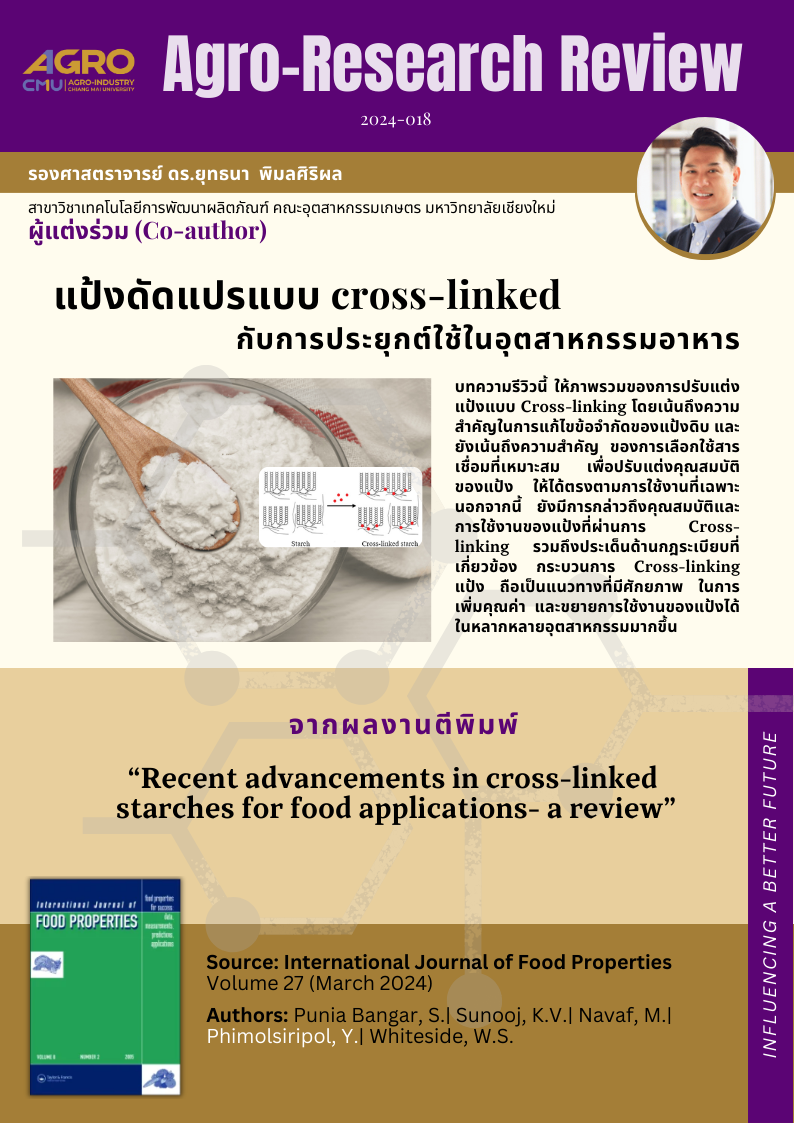
แนะนำงานวิจัย 2024-018 แป้งดัดแปรแบบ cross-linked กับการประยุกต์ใช้ในอุตสาหกรรมอาหาร
บทความรีวิวนี้ ให้ภาพรวมของการปรับแต่งแป้งแบบ Cross-linking โดยเน้นความสำคัญในการแก้ไขข้อจำกัดของแป้งดิบ และเน้นถึงความสำคัญของการเลือกใช้สารเชื่อมที่เหมาะสม เพื่อปรับแต่งคุณสมบัติของแป้งให้ตรงตามการใช้งานเฉพาะ นอกจากนี้ ยังมีการกล่าวถึงคุณสมบัติและการใช้งานของแป้งที่ผ่านการ Cross-linking รวมถึงประเด็นด้านกฎระเบียบที่เกี่ยวข้อง กระบวนการ Cross-linking แป้งถือเป็นแนวทางที่มีศักยภาพในการเพิ่มคุณค่าและขยายการใช้งานแป้งได้ในหลากหลายอุตสาหกรรมมากขึ้น
This review paper offers an overview of cross-linking modifications, emphasizing their importance in addressing native starch limitations. It underscores the significance of selecting appropriate cross-linking agents to customize starch properties for specific applications. Furthermore, the paper discusses the properties and applications of cross-linked starches and delves into regulatory considerations regarding their use. Regulatory consideration for cross-linked starches has also been discussed. Cross-linking modifications offer a promising avenue to unlock the full potential of starch and expand its utility across a wide range of applications.
Topic: Recent advancements in cross-linked starches for food applications- a review
Authors: Punia Bangar, S.| Sunooj, K.V.| Navaf, M.| Phimolsiripol, Y.| Whiteside, W.S.
Abstract:
The industrial food applications of native starches are limited due to their limited resistance to shear, susceptibility to thermal decomposition, and high tendency for retrogradation. Cross-linking of starches adds intra and inter-molecular bonds at various locations in the starch molecule that result in the stability of the granule and enhance functional attributes. This process involves the use of various cross-linking agents such as sodium trimetaphosphate (STMP), sodium tripolyphosphate (STPP), epichlorohydrin (EPI), phosphorus chloride (POCl3), and citric acid, etc., to introduce covalent or non-covalent linkages between starch molecules. Cross-linked starch exhibits improved resistance to retrogradation, enhanced freeze-thaw stability, and increased stability during cooking, shearing, and processing, such as high or low temperatures and pH. This review paper offers an overview of cross-linking modifications, emphasizing their importance in addressing native starch limitations. It underscores the significance of selecting appropriate cross-linking agents to customize starch properties for specific applications. Furthermore, the paper discusses the properties and applications of cross-linked starches and delves into regulatory considerations regarding their use. Regulatory consideration for cross-linked starches has also been discussed. Cross-linking modifications offer a promising avenue to unlock the full potential of starch and expand its utility across a wide range of applications.
Keywords: cross-linking; epichlorohydrin; Modifications; pasting; rheology; STMP; STPP
View at publisher: https://www.tandfonline.com/doi/full/10.1080/10942912.2024.2318427#abstract
#อกมช. #agrocmu #CMU



